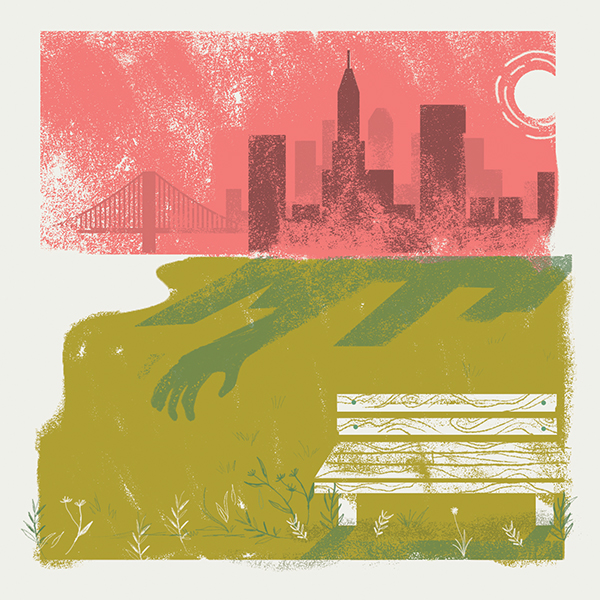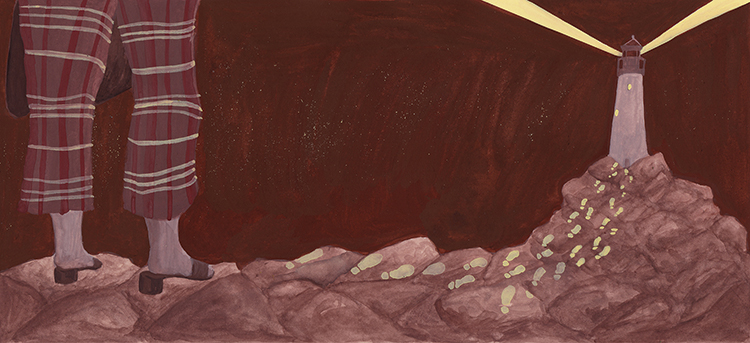Illustration by Wyatt Glennon
Betting the Farm
by Amy Laura Cahn
Philadelphia needs to act quickly if it does not want to lose its community gardens. We can’t do it without leadership from the Kenney administration.
On March 20, a Philadelphia Inquirer headline read “Growing Pains for Gardeners: South Kensington plots may be lost amid growth, but the farmers are fighting back.” It tells the story of what has come to be called La Finquita or “the little farm,” established in 1988 by the Philadelphia Catholic Worker. Once an abandoned post-industrial dumping site, the garden now supplies the Catholic Worker and Drueding Center soup kitchens, a weekly farmstand and many neighbors. But after 28 years as a neighborhood mainstay, development—amid a rapidly changing neighborhood—threatens this precious space.
Last spring, the Philadelphia Housing Authority (PHA) displaced the North Philly Peace Park, which provided fresh produce to neighboring seniors. The Peace Park is still searching for a new home, as PHA begins to remake the neighborhood.
This story keeps repeating itself throughout the city, particularly in increasingly hot real estate markets. Last fall, National Geographic profiled the wildly productive Growing Home Gardens, which serves South Philadelphia’s Bhutanese and Burmese refugee community. Within weeks of the story, it was uncertain whether some of those parcels were to go up for sheriff’s sale.
West Philadelphia’s Farm 51 recently eluded sheriff’s sale, but its future is uncertain. As it is for Cohocksink Community Garden. University City Garden. Saint Bernard Community Garden. Sloan Street Community Garden. Mill Creek Farm. The list goes on.
Some of these spaces have already been lost or relocated. Of those that remain, not one is secure. The same goes for hundreds of gardens across the city. Even after more than 30 years of vibrant activity, many gardens have never had the option to secure stable land tenure. Philadelphia has lacked the city policy, commitment and leadership to provide assurance, site control and long-term preservation, and instead deemed gardening and farming “interim uses” for parcels awaiting more profitable uses.
Philadelphians talk about our “40,000 vacant lots,” spaces that manifested from decades of neighborhood disinvestment and abandonment. But we don’t talk enough about the decades of neighbors, particularly in communities of color and immigrant communities, who made certain that many spaces never became vacant. And we definitely don’t talk enough about how to honor and preserve the work of neighbors who continue to step up, transforming abandoned properties into community assets.
As development picks up in Philadelphia and land becomes more valuable, we need to ensure that the communities that have been investing in themselves don’t lose out. And as we move forward with policies that shape changing neighborhoods, this city needs to ensure that more would-be community land stewards have a clear path to obtain—and preserve—land.
When it is fully up and running, the Philadelphia Land Bank will be the tool this city needs to facilitate garden preservation; it will streamline and make transparent how we access publicly owned and privately owned tax delinquent land, including garden parcels. Its strategic plan states “[i]f properties are already in use as an active and maintained community garden, this use will be protected.”
This could signal a paradigm shift from urban agriculture as interim use to recognizing it as a use that has been critical to the fabric of our neighborhoods for more than a generation. But the Land Bank is simply a tool. What matters is how we use it. And that will be guided by priorities set by our new mayor.
Under the Nutter administration, the Greenworks plan declared preservation of green space and increased access to healthy food key sustainability goals. The Philadelphia Water Department embarked on innovative green stormwater infrastructure projects with gardeners as a critical partner. The Office of Sustainability began exploring the need to mitigate impacts of a warming climate. Gardens, farms and open spaces have been recognized as contributing to these goals, but have never been made a priority.
The Kenney administration has affirmed a commitment to improving our neighborhoods, including parks and recreation centers. But we still do not know how community-managed gardens, farms and open spaces will fare. In a decision between a decades-old garden or a new development, we do not know what will win out.
If these decisions are made on a case-by-case basis, gardens will get picked off one by one. We need the Kenney administration to direct all relevant agencies to work together on a coordinated approach to aggressively protect the investments that communities have already made. And we need this city to retire the notion altogether that gardens are simply interim use. Generations of Philadelphia gardeners have proven otherwise.
Amy Laura Cahn is a staff attorney with the Public Interest Law Center where she directs the Garden Justice Legal Initiative and works to preserve gardens, including La Finquita and Farm 51.







